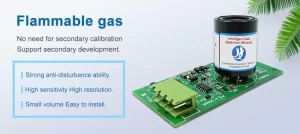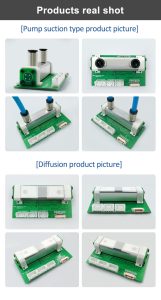As the world's population continues to grow, more and more people are moving to urban areas, leading to an increase in air pollution. Poor air quality has been linked to a variety of health problems, including respiratory diseases, heart disease, and even cancer. In response to this growing concern, cities around the world are turning to smart technologies to monitor and manage air quality. Gas sensors, in particular, are playing a crucial role in this effort, providing real-time data on air pollution levels and helping to identify sources of contamination.

The Need for Smart Air Quality Management
Urban air pollution is a complex and dynamic problem that requires a sophisticated and responsive approach to manage. Traditional air quality monitoring systems, which rely on fixed stations to collect data, are limited in their ability to provide real-time information on pollution levels. This makes it difficult for city officials to respond quickly to changing conditions and to take targeted action to reduce pollution. Smart air quality management systems, on the other hand, use a network of sensors to continuously monitor air pollution levels across a city, providing real-time data that can be used to inform decision-making and policy development.
Gas Sensors: The Key to Smart Air Quality Management
Gas sensors are at the heart of smart air quality management systems, providing the real-time data that is essential for effective pollution control. These sensors are able to detect a wide range of pollutants, including carbon monoxide, nitrogen dioxide, sulfur dioxide, and particulate matter. By continuously monitoring these pollutants, gas sensors can provide city officials with a detailed picture of air quality across different areas of a city, allowing them to identify pollution hotspots and sources of contamination.
In addition to providing real-time data on pollution levels, gas sensors can also be used to identify the sources of pollution. For example, by using a network of sensors to monitor pollution levels at different points in a city, it is possible to track the movement of pollutants and to identify the sources of contamination. This information can then be used to develop targeted strategies to reduce pollution, such as implementing traffic restrictions in areas with high levels of nitrogen dioxide or introducing new regulations for industrial emissions.
The Role of Gas Sensors in Smart Cities
Gas sensors are playing a crucial role in the development of smart cities, where technology is being used to improve the quality of life for residents and to create more sustainable and efficient urban environments. In addition to their role in air quality management, gas sensors are also being used to monitor a wide range of environmental conditions, including temperature, humidity, and noise levels. This data can be used to inform a variety of city services, such as traffic management, waste collection, and energy consumption.
In the context of air quality management, gas sensors are being integrated into a wide range of smart city initiatives. For example, in London, gas sensors are being used to monitor pollution levels in real time, providing city officials with the data they need to take targeted action to reduce pollution. In Singapore, gas sensors are being used to monitor pollution levels in public spaces, allowing city officials to provide residents with real-time information on air quality.
Challenges and Opportunities
While gas sensors have the potential to revolutionize air quality management in cities, there are still a number of challenges that need to be addressed. One of the main challenges is the cost of deploying and maintaining a network of gas sensors across a city. However, advances in sensor technology are making it increasingly cost-effective to deploy large-scale sensor networks, and the long-term benefits of improved air quality are likely to outweigh the initial investment.
Another challenge is the need to ensure that the data collected by gas sensors is accurate and reliable. This requires careful calibration and maintenance of the sensors, as well as the development of robust data analysis and visualization tools. However, advances in sensor technology and data analytics are making it easier to collect, analyze, and visualize large volumes of data, allowing city officials to make informed decisions about air quality management.

Conclusion
Smart cities are using gas sensors to improve air quality management, providing real-time data on pollution levels and helping to identify sources of contamination. By continuously monitoring pollutants and providing city officials with detailed information on air quality across different areas of a city, gas sensors are playing a crucial role in the development of smart air quality management systems. While there are still challenges to be addressed, the potential benefits of improved air quality in urban areas are significant, making the deployment of gas sensors an important step towards creating cleaner and healthier cities.
 : +86 155 8830 2704
: +86 155 8830 2704 : jxdziot@gmail.com
: jxdziot@gmail.com
